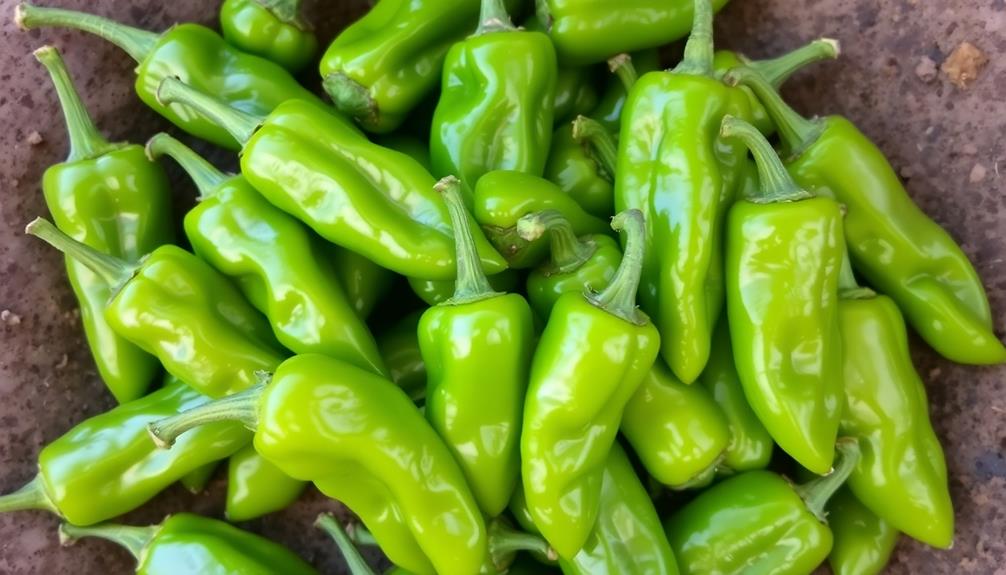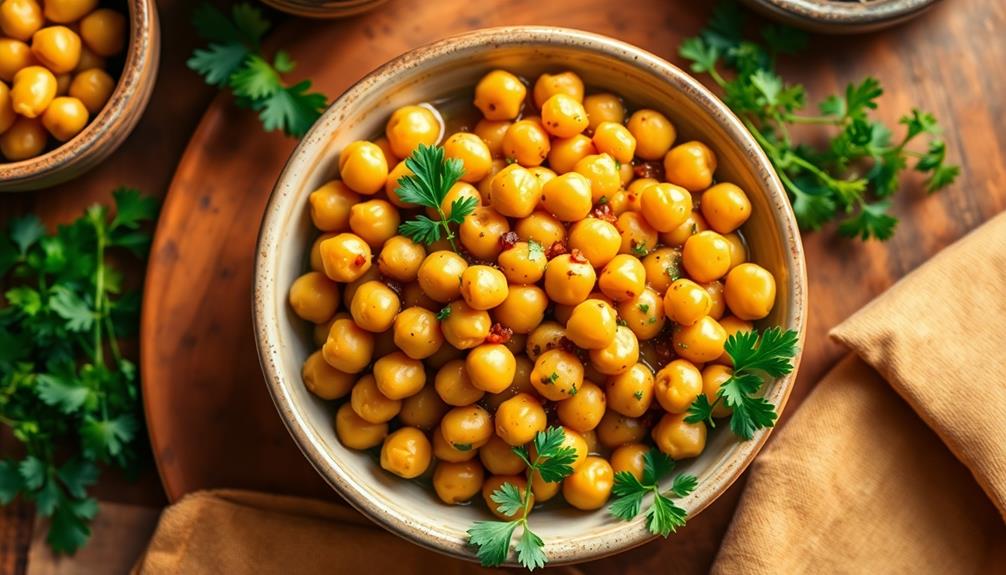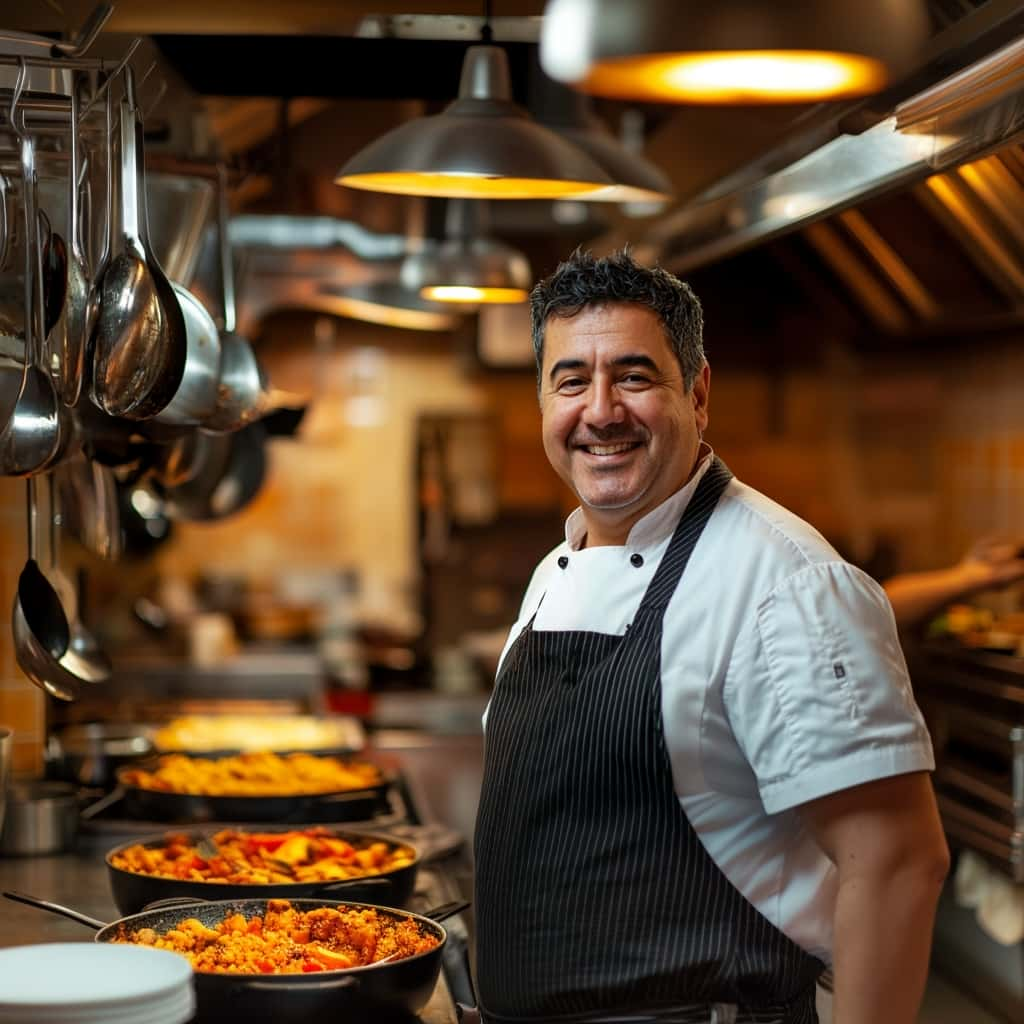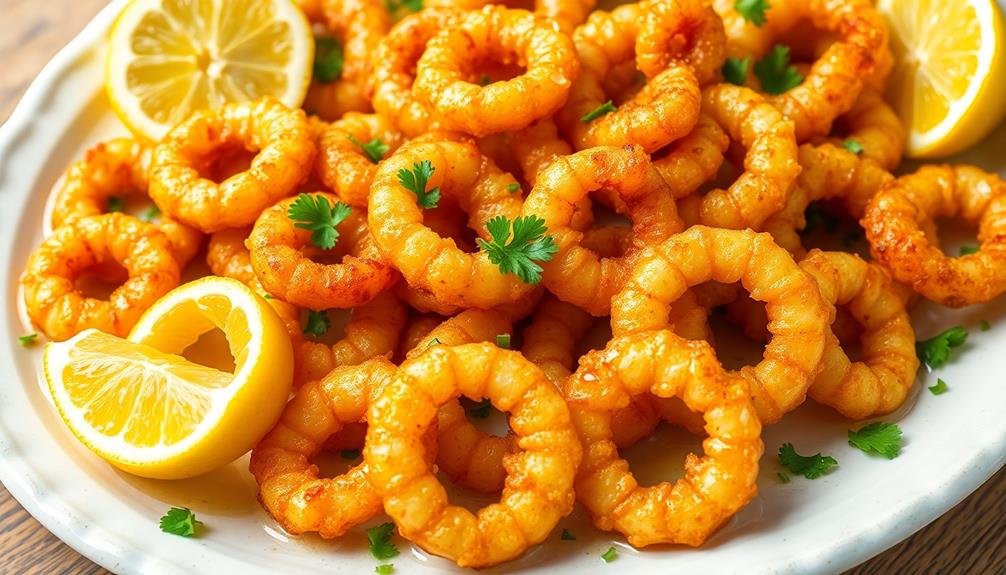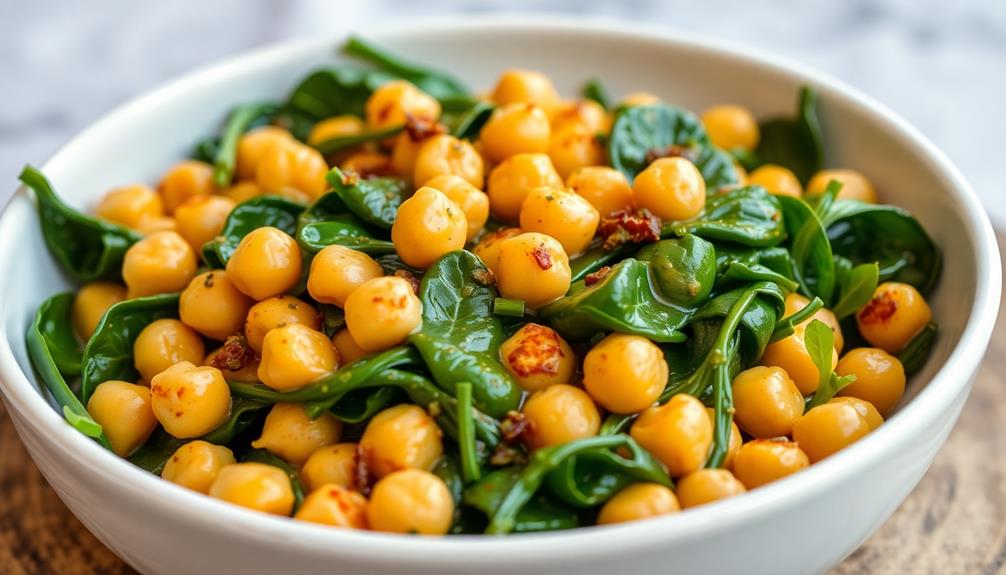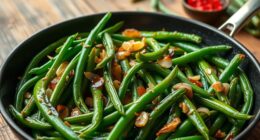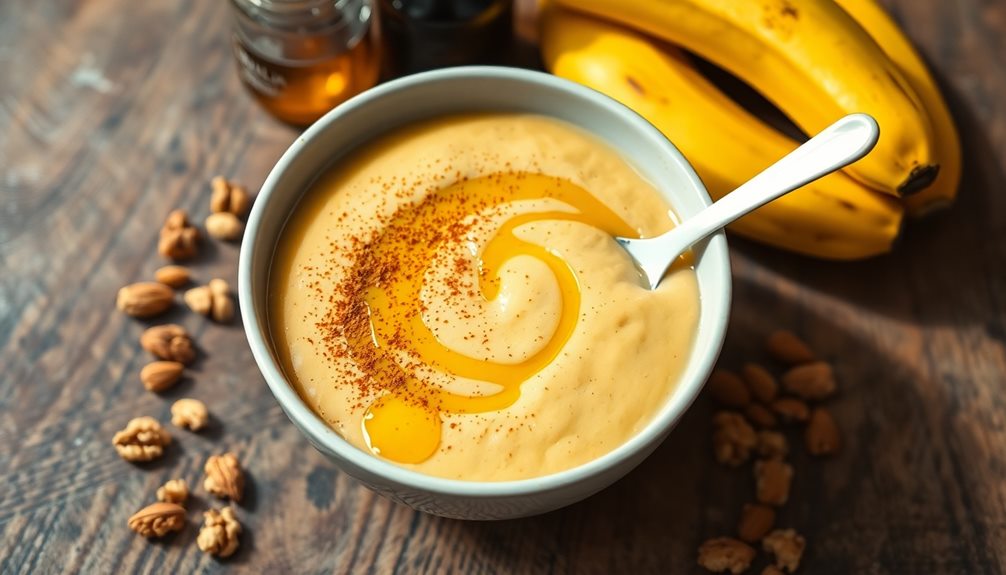Padrón peppers are a beloved Spanish delicacy hailing from the Galician region. These small, green peppers boast a captivating flavor profile – sometimes mild and sweet, other times pleasantly spicy. Traditionally, they're lightly fried in olive oil and sprinkled with coarse sea salt, which enhances their natural sweetness. Beyond their distinctive taste, Padrón peppers are low in calories and rich in vitamins, making them a healthy snack option. Whether you're grilling, sautéing, or frying them, these versatile peppers pair perfectly with a variety of dishes. Their growing global popularity reflects an appreciation for their unique character. If you're intrigued to learn more, keep reading to discover the full story behind these captivating Galician gems.
Key Takeaways
- Padrón peppers are small, green peppers originating from Padrón, Spain, with a unique flavor profile ranging from mild to occasionally spicy.
- They are traditionally enjoyed fried in olive oil and sprinkled with coarse sea salt, serving as a popular tapas dish in Spanish cuisine.
- Padrón peppers are rich in vitamins A and C, providing antioxidants and dietary fiber, making them a healthy snack option.
- The peppers' versatility allows them to be used in various culinary applications, from grilling and sautéing to enhancing the flavor of main dishes.
- Padrón peppers have gained global popularity, reflecting their culinary significance and appeal to food enthusiasts worldwide.
History
The origins of Padrón peppers can be traced back to the small town of Padrón, located in the northwestern region of Spain. These diminutive green peppers have been a local delicacy for centuries, cultivated by generations of farmers in the Galicia province.
Padrón peppers thrive in the mild, maritime climate of this coastal region, where the cool Atlantic air and frequent rainfall create the perfect growing conditions. The plants are relatively hardy, producing an abundance of small, wrinkled pods that turn from green to golden brown as they mature.
Traditionally, Padrón peppers were enjoyed as a simple, rustic snack, lightly fried in olive oil and sprinkled with coarse sea salt. This preparation allowed the peppers' distinct, slightly smoky flavor to shine, making them a beloved staple in the local cuisine.
Today, the popularity of Padrón peppers has spread far beyond their humble Galician origins, with gourmets around the world seeking out this unique and flavorful variety.
Recipe
Padrón peppers are a specialty of the Galicia region in northwestern Spain. These small, green peppers have a delightfully mild and slightly sweet flavor, with an occasional spicy kick. When cooked properly, they develop a delicate, blistered skin that contrasts beautifully with the tender, juicy flesh inside.
The simplicity of this dish allows the natural flavors of the peppers to shine. It's a perfect appetizer or side dish that pairs wonderfully with a glass of chilled white wine or a crisp lager. If you’re new to cooking or just looking for a quick and easy dish to impress your guests, this delicious stuffed pepper recipe is a must-try. The combination of sweet and savory flavors will tantalize your taste buds, and the vibrant colors of the peppers will add a pop of brightness to your table. Whether you’re hosting a dinner party or simply craving a flavorful snack, these stuffed peppers are sure to be a hit.
- Padrón peppers
- Olive oil
- Flaky sea salt
Heat a large skillet or cast-iron pan over high heat. Add a generous amount of olive oil, enough to lightly coat the bottom of the pan. Once the oil is shimmering, add the Padrón peppers in a single layer. Cook, turning occasionally, until the peppers are blistered and lightly charred on all sides, about 5-7 minutes.
Immediately transfer the hot peppers to a serving plate and sprinkle generously with flaky sea salt. Serve hot, encouraging your guests to pick up the peppers by the stem and enjoy the delightful contrast of the crisp exterior and tender interior.
Be cautious, as an occasional Padrón pepper may be spicier than the rest.
Cooking Steps
Rinse and pat the Padrón peppers dry with a clean towel.
Heat a generous amount of oil in a large skillet over medium-high heat.
Carefully add the peppers to the hot oil and cook, turning occasionally, until they're nicely blistered all over.
Finish by sprinkling the roasted peppers with a hefty pinch of coarse salt.
Step 1. Rinse and Pat Dry Peppers
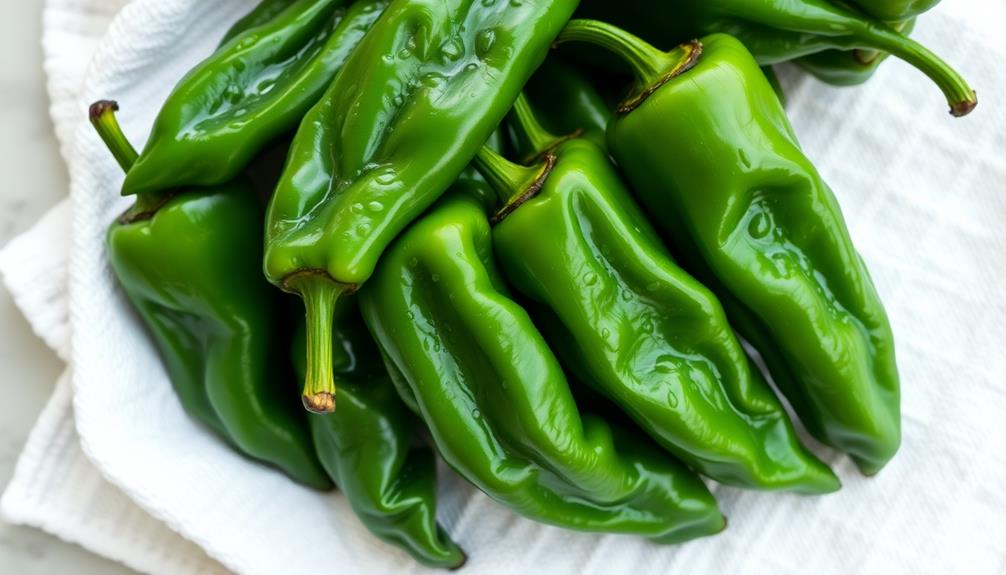
Gently rinse the peppers under cool, running water to remove any dirt or debris.
Once rinsed, use a clean paper towel or kitchen cloth to pat the peppers dry. This step is crucial to ensure the peppers cook evenly and develop a nice char or blister on the skin.
Be sure to handle the peppers carefully, as they can be delicate. Lay the dried peppers on a clean work surface or baking sheet, ready for the next step in the cooking process.
Removing any excess moisture from the peppers will help them sear and blister beautifully when you cook them.
Take the time to thoroughly pat them dry, ensuring every inch of the pepper's surface is free of water.
With the peppers prepped and ready, you're now one step closer to enjoying the incredible flavor of these unique and delightful pimientos de Padrón.
Step 2. Heat Oil in Pan
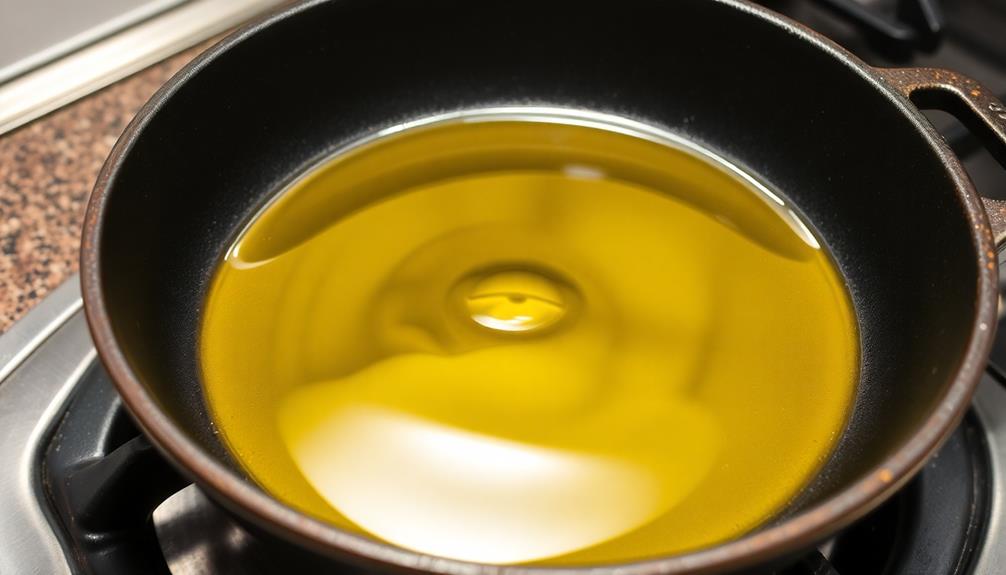
Next, heat a large, heavy-bottomed pan or skillet over medium-high heat.
Once it's nice and hot, add a few tablespoons of high-quality olive oil. Swirl the pan to coat the bottom evenly. You'll know the oil is ready when it starts to shimmer and release its aroma.
Carefully add the rinsed and dried Padrón peppers to the hot oil, arranging them in a single layer. They'll sizzle enthusiastically as they hit the pan.
Let them cook for 2-3 minutes, or until the undersides start to blister and turn golden-brown. Shake the pan occasionally to ensure even cooking.
Once the first side is nicely charred, use tongs to flip the peppers over and cook for another 2-3 minutes on the other side. The goal is to achieve an even, flavorful char all over the peppers.
Keep a close eye on them to prevent burning. When they're done, transfer the Padrón peppers to a serving plate or bowl, ready to be seasoned and enjoyed.
Step 3. Add Peppers to Hot Oil
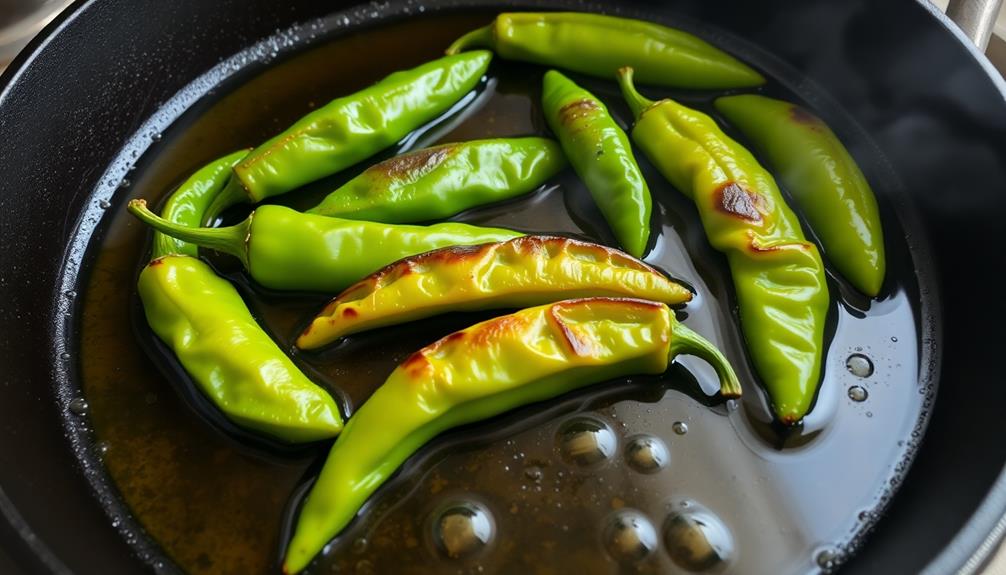
Carefully add the rinsed and dried Padrón peppers to the hot oil, arranging them in a single layer. Hear the satisfying sizzle as the peppers hit the pan – it's time to work your culinary magic!
Gently toss the peppers, ensuring each one gets a chance to brown and blister. Keep a close eye, as these peppers can go from perfect to charred in the blink of an eye. After a minute or two, when the peppers have developed a gorgeous, blistered exterior, give them a gentle stir.
Be mindful of any popping or splattering – these little guys pack a punch! Continue cooking, turning the peppers occasionally, until they're tender and slightly softened, about 3-5 minutes total.
Resist the urge to overcrowd the pan, as you want the peppers to have enough space to cook evenly. Once they're perfectly cooked, transfer the Padrón peppers to a serving dish and get ready to enjoy their bold, vibrant flavor.
Step 4. Cook Until Blistered
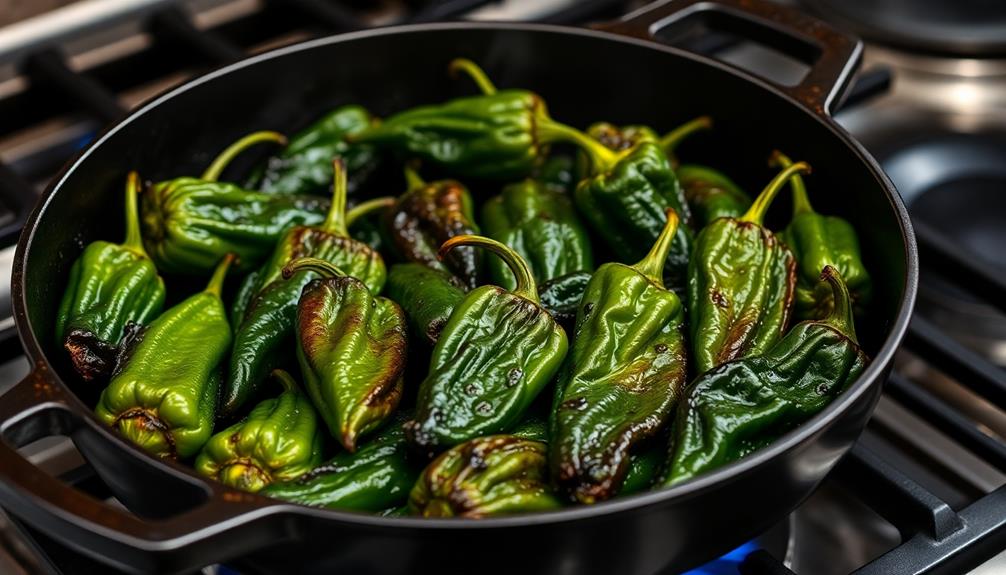
The peppers' sizzle as they hit the hot oil signals the start of the cooking process.
You'll want to keep a close eye on them, stirring frequently, as they blister and char. This is where the magic happens – the peppers' natural sugars caramelize, creating a delightful depth of flavor.
Don't be afraid to let them get a little blackened in spots. That's exactly what you're going for! The charring adds a wonderful smoky note that balances the peppers' bright, fresh taste. Just be sure to keep them moving, so they don't burn.
As the peppers cook, you'll notice the skin starting to pucker and blister. This is a good sign – it means the peppers are transforming into something truly special.
Once they've reached your desired level of blistering, remove them from the heat and transfer them to a serving dish.
Get ready to enjoy the bold, smoky-sweet flavor of perfectly cooked Padrón peppers.
Step 5. Sprinkle With Coarse Salt
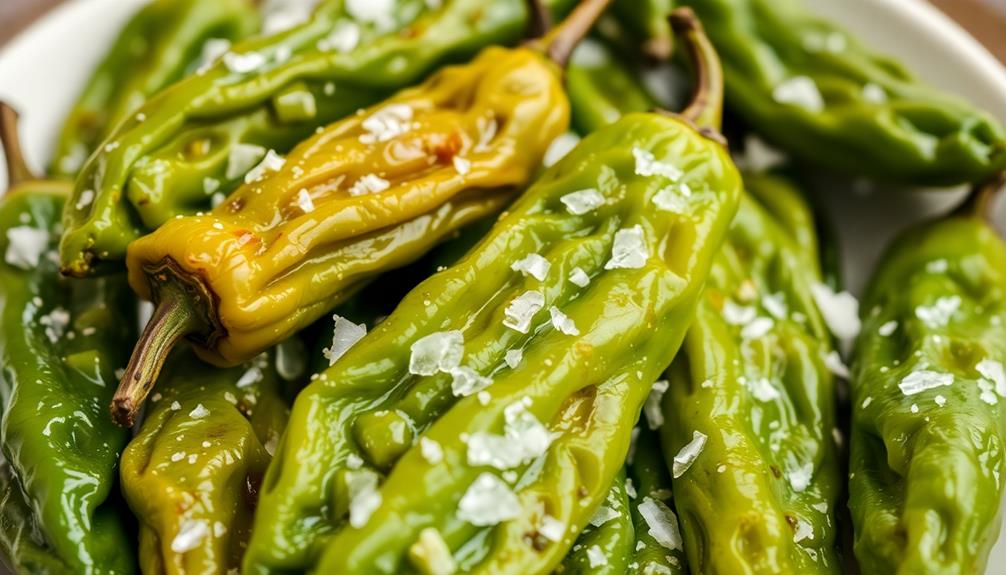
As the charred Padrón peppers rest on the serving dish, it's time to add the finishing touch – a sprinkle of coarse salt. This simple step enhances the natural sweetness and brings out the roasted flavors of the peppers.
Reach for a high-quality, crunchy sea salt or Maldon salt. Pinch the salt between your fingers and let it gently fall over the peppers, covering them evenly. The large, flaky crystals will create a delightful contrast to the soft, blistered skin of the peppers.
The salt not only seasons the dish, but also provides a satisfying texture. As you take a bite, the crunch of the salt gives way to the juicy, slightly spicy pepper. It's a perfect balance of flavors and sensations, making each bite a delightful experience.
Don't be shy – be generous with the salt. The Padrón peppers can handle a healthy dose, so sprinkle until the dish glistens.
Now, dig in and enjoy the perfect pairing of charred peppers and crunchy salt.
Final Thoughts
Padrón peppers are a versatile and delightful addition to any culinary adventure. Whether you're grilling, sautéing, or enjoying them straight from the pan, these small green peppers offer a unique flavor profile that can elevate any dish. The subtle sweetness, with a hint of bitterness, makes them a crowd-pleasing favorite.
As you savor the final moments of your Padrón pepper experience, remember that these dynamic little peppers can be enjoyed in countless ways. Experiment with different cooking techniques, pair them with a variety of proteins and sides, or simply relish them as a tasty snack.
The possibilities are endless, and the joy they bring to the table is unparalleled. So, the next time you encounter these captivating peppers, embrace the adventure and let your culinary creativity shine. Padrón peppers are a delicious reminder that the most remarkable flavors can often be found in the simplest of ingredients.
Frequently Asked Questions
Where Can I Buy Pimientos De Padrón Peppers?
You can find pimientos de padrón peppers at specialty grocery stores, farmers' markets, or online retailers that sell gourmet and hard-to-find ingredients. They're a popular Spanish pepper with a unique flavor profile.
How Spicy Are Pimientos De Padrón Peppers?
Pimientos de Padrón peppers can range from mild to quite spicy, with about one in ten being much hotter than the rest. You never know what you're going to get, which is part of their appeal.
Can I Substitute Other Peppers for Pimientos De Padrón?
You can substitute other peppers for pimientos de padrón, but the flavor and heat level won't be quite the same. Try using shishito or Cubanelle peppers, which have a similar mild, sweet taste.
How Long Do Pimientos De Padrón Last After Harvesting?
Freshly harvested peppers typically last about 3-5 days when stored in the refrigerator. However, their shelf life can vary depending on factors like storage conditions and handling. Proper storage is key to maximizing the freshness of these delicate peppers.
Are Pimientos De Padrón High in Any Specific Nutrients?
Yes, pimientos de padrón are high in certain nutrients. They're a good source of vitamin C, vitamin A, and antioxidants. Enjoying these flavorful peppers can provide a nice nutritional boost to your diet.
